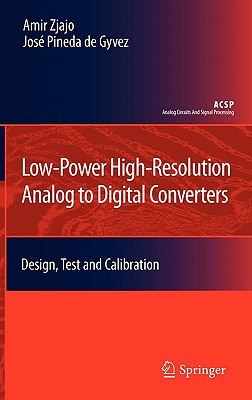Modular Low-Power, High-Speed CMOS Analog-To-Digital Converter for Embedded Systems
暫譯: 嵌入式系統的模組化低功耗高速度CMOS類比轉數位轉換器
Keh-La Lin, Armin Kemna, Bedrich J. Hosticka
買這商品的人也買了...
-
 CMOS Data Converters for Communications (Hardcover)
CMOS Data Converters for Communications (Hardcover)$8,900$8,455 -
 C++ Builder 6 完全攻略
C++ Builder 6 完全攻略$690$587 -
 CMOS Integrated Analog-To-Digital and Digital-To-Analog Converters, 2/e
CMOS Integrated Analog-To-Digital and Digital-To-Analog Converters, 2/e$1,200$1,176 -
 Windows CE 嵌入式系統理論與實務
Windows CE 嵌入式系統理論與實務$680$537 -
 Windows 程式設計使用 MFC (Programming Windows with MFC, 2/e)
Windows 程式設計使用 MFC (Programming Windows with MFC, 2/e)$990$782 -
 第五項修練-學習型組織的藝術與實務, 3/e
第五項修練-學習型組織的藝術與實務, 3/e$600$510 -
 深入淺出 Java 程式設計, 2/e (Head First Java, 2/e)
深入淺出 Java 程式設計, 2/e (Head First Java, 2/e)$880$695 -
 CSS 功能索引式參考手冊
CSS 功能索引式參考手冊$390$332 -
 SQL Server 2005 資料庫開發聖經
SQL Server 2005 資料庫開發聖經$890$757 -
 鳥哥的 Linux 私房菜基礎學習篇, 2/e
鳥哥的 Linux 私房菜基礎學習篇, 2/e$780$663 -
 Microsoft SQL Server 2005 設計實務
Microsoft SQL Server 2005 設計實務$680$578 -
 駭客攻防技術擂臺
駭客攻防技術擂臺$520$442 -
 Ajax 網頁程式設計─Google 成功背後的技術
Ajax 網頁程式設計─Google 成功背後的技術$580$493 -
 Low-Voltage CMOS Log Companding Analog Design
Low-Voltage CMOS Log Companding Analog Design$1,600$1,568 -
 Ajax 與 Google Map API 入門實作
Ajax 與 Google Map API 入門實作$450$351 -
 ASP.NET 2.0 深度剖析範例集
ASP.NET 2.0 深度剖析範例集$650$507 -
 PHP + MySQL 快速入門
PHP + MySQL 快速入門$680$537 -
 Ajax 技術手冊 (Foundations of Ajax)
Ajax 技術手冊 (Foundations of Ajax)$450$356 -
 聖殿祭司的 ASP.NET 2.0 專家技術手冊─使用 C#
聖殿祭司的 ASP.NET 2.0 專家技術手冊─使用 C#$720$569 -
 現代嵌入式系統開發專案實務-菜鳥成長日誌與專案經理的私房菜
現代嵌入式系統開發專案實務-菜鳥成長日誌與專案經理的私房菜$600$480 -
 Principles of Instrumental Analysis, 6/e (IE) (美國版ISBN:0495012017)
Principles of Instrumental Analysis, 6/e (IE) (美國版ISBN:0495012017)$1,100$1,078 -
 CMOS Circuit Design, Layout, and Simulation, 2/e 增訂版
CMOS Circuit Design, Layout, and Simulation, 2/e 增訂版$1,590$1,558 -
 大話設計模式
大話設計模式$620$490 -
 Google Android SDK 開發範例大全
Google Android SDK 開發範例大全$750$593 -
 Windows Device Driver Programming 驅動程式設計
Windows Device Driver Programming 驅動程式設計$650$507
相關主題
商品描述
Description
One of the main trends of microelectronics is toward design for integrated systems, i.e., system-on-a-chip (SoC) or system-on-silicon (SoS). Due to this development, design techniques for mixed-signal circuits become more important than before. Among other devices, analog-to-digital and digital-to-analog converters are the two bridges between the analog and the digital worlds. Besides, low-power design technique is one of the main issues for embedded systems, especially for hand-held applications.
Modular Low-Power, High-Speed CMOS Analog-to-Digital Converter for Embedded Systems aims at design techniques for low-power, high-speed analog-to-digital converter processed by the standard CMOS technology. Additionally this book covers physical integration issues of A/D converter integrated in SoC, i.e., substrate crosstalk and reference voltage network design.
Foreword. List of Figures. List of Tables.
1: Introduction. 1.1. Motivation. 1.2. Organization of the Book.
2: Analog-to-Digital Conversion. 2.1. Concepts of A/D Conversion and D/A Conversion. 2.2. Sampling Theorem of the A/D Conversion. 2.3. Quantization Process of the A/D conversion. 2.4. Performance of A/D Converters. 2.5. Topologies and Architectures of High-Speed A/D Converters. 2.6. Problems of Embedded System with A/D Converter. 2.7. Summary.
3: Components for CMOS Folding and Interpolating A/D Converters. 3.1. Subsystem: Sample-and-Hold Amplifier. 3.2. High-Speed Operational Transconductance Amplifier. 3.3. Subsystem: Fine Converter. 3.4. Subsystem: Coarse Converter. 3.5. Comparator Stage. 3.6. Digital Signal Processing: Error Correction. 3.7. Digital Signal Processing: Algorithm for Binary Coding. 3.8. Subsystem: Synchronization.
4: Architecture and Design of CMOS Folding and Interpolating A/D Converters. 4.1. Introduction. 4.2. Architecture Optimization. 4.3. Design and Implementation of the 10-Bit Folding and Interpolating A/D Converter. 4.4. Architectural Scalability of the Folding and Interpolating A/D Converter. 4.5. Architecture Analysis for the 10-Bit Folding and Interpolating A/D Converter. 4.6. Architectural Hard Scaling. 4.7. Summary.
5: Physical Design of Low-Power, High Embedded CMOS A/D Converter. 5.1. Power Supply Network. 5.2. Reference Voltage Network. 5.3. Noise Coupling. 5.4. Summary of Recommended Design Practices for Low-Power, High-Speed CMOS Analog-to-Digital Converter for Embedded Systems.
6: Evaluation and Measurements. 6.1. Methodology for Analog Measurement. 6.2. Methodology for Digital Measurement. 6.3. Measurement Results. 6.4. Summary.
7: General Conclusions and Outlook.
Appendix A: Analysis for Small Signal Operation.
Appendix B: Source Codes for Binary Coding.
Appendix C: Test Results: Folding ADC vs. AD9203.
Symbols, Conventions, Notations, and Abbreviations.
Index. Bibliography.
商品描述(中文翻譯)
**描述**
微電子學的主要趨勢之一是針對集成系統的設計,即系統單晶片(SoC)或系統在矽上(SoS)。由於這一發展,混合信號電路的設計技術變得比以往更為重要。在其他設備中,模擬到數位(A/D)轉換器和數位到模擬(D/A)轉換器是模擬世界與數位世界之間的兩座橋樑。此外,低功耗設計技術是嵌入式系統的主要議題之一,特別是對於手持應用。
**模組化低功耗、高速CMOS模擬到數位轉換器**旨在針對使用標準CMOS技術處理的低功耗、高速模擬到數位轉換器的設計技術。此外,本書還涵蓋了集成在SoC中的A/D轉換器的物理集成問題,即基板串擾和參考電壓網路設計。
**目錄**
前言。圖表清單。表格清單。
**1:引言。1.1.** 動機。 **1.2.** 本書組織。
**2:模擬到數位轉換。2.1.** A/D轉換和D/A轉換的概念。 **2.2.** A/D轉換的取樣定理。 **2.3.** A/D轉換的量化過程。 **2.4.** A/D轉換器的性能。 **2.5.** 高速A/D轉換器的拓撲和架構。 **2.6.** 嵌入式系統中A/D轉換器的問題。 **2.7.** 總結。
**3:CMOS折疊和插值A/D轉換器的組件。3.1.** 子系統:取樣保持放大器。 **3.2.** 高速運算跨導放大器。 **3.3.** 子系統:精細轉換器。 **3.4.** 子系統:粗略轉換器。 **3.5.** 比較器階段。 **3.6.** 數位信號處理:錯誤修正。 **3.7.** 數位信號處理:二進位編碼的演算法。 **3.8.** 子系統:同步。
**4:CMOS折疊和插值A/D轉換器的架構與設計。4.1.** 引言。 **4.2.** 架構優化。 **4.3.** 10位折疊和插值A/D轉換器的設計與實現。 **4.4.** 折疊和插值A/D轉換器的架構可擴展性。 **4.5.** 10位折疊和插值A/D轉換器的架構分析。 **4.6.** 架構硬擴展。 **4.7.** 總結。
**5:低功耗、高速嵌入式CMOS A/D轉換器的物理設計。5.1.** 電源網路。 **5.2.** 參考電壓網路。 **5.3.** 噪聲耦合。 **5.4.** 低功耗、高速CMOS模擬到數位轉換器的推薦設計實踐總結。
**6:評估與測量。6.1.** 模擬測量的方法論。 **6.2.** 數位測量的方法論。 **6.3.** 測量結果。 **6.4.** 總結。
**7:一般結論與展望。**
**附錄A:** 小信號操作的分析。
**附錄B:** 二進位編碼的源代碼。
**附錄C:** 測試結果:折疊ADC與AD9203。
符號、慣例、標記和縮寫。
索引。
參考文獻。











